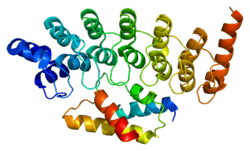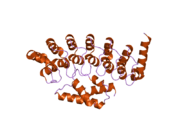PSMC4
26S protease regulatory subunit 6B is an enzyme that in humans is encoded by the PSMC4 gene.[1][2][3]
Function
The 26S proteasome is a multicatalytic proteinase complex with a highly ordered structure composed of 2 complexes, a 20S core and a 19S regulator. The 20S core is composed of 4 rings of 28 non-identical subunits; 2 rings are composed of 7 alpha subunits and 2 rings are composed of 7 beta subunits. The 19S regulator is composed of a base, which contains 6 ATPase subunits and 2 non-ATPase subunits, and a lid, which contains up to 10 non-ATPase subunits. Proteasomes are distributed throughout eukaryotic cells at a high concentration and cleave peptides in an ATP/ubiquitin-dependent process in a non-lysosomal pathway. An essential function of a modified proteasome, the immunoproteasome, is the processing of class I MHC peptides. This gene encodes one of the ATPase subunits, a member of the triple-A family of ATPases which have a chaperone-like activity. This subunit has been shown to interact with an orphan member of the nuclear hormone receptor superfamily highly expressed in liver, and with gankyrin, a liver oncoprotein. Two transcript variants encoding different isoforms have been identified.[3]
Interactions
PSMC4 has been shown to interact with:
References
- ↑ Tanahashi N, Suzuki M, Fujiwara T, Takahashi E, Shimbara N, Chung CH et al. (Mar 1998). "Chromosomal localization and immunological analysis of a family of human 26S proteasomal ATPases". Biochem Biophys Res Commun 243 (1): 229–32. doi:10.1006/bbrc.1997.7892. PMID 9473509.
- ↑ Choi HS, Seol W, Moore DD (May 1996). "A component of the 26S proteasome binds on orphan member of the nuclear hormone receptor superfamily". J Steroid Biochem Mol Biol 56 (1–6 Spec No): 23–30. doi:10.1016/0960-0760(95)00220-0. PMID 8603043.
- ↑ 3.0 3.1 "Entrez Gene: PSMC4 proteasome (prosome, macropain) 26S subunit, ATPase, 4".
- ↑ 4.0 4.1 4.2 4.3 Ewing RM, Chu P, Elisma F, Li H, Taylor P, Climie S et al. "Large-scale mapping of human protein-protein interactions by mass spectrometry". Mol. Syst. Biol. 3: 89. doi:10.1038/msb4100134. PMC 1847948. PMID 17353931.
- ↑ Hartmann-Petersen R, Tanaka K, Hendil KB (Feb 2001). "Quaternary structure of the ATPase complex of human 26S proteasomes determined by chemical cross-linking". Arch. Biochem. Biophys. 386 (1): 89–94. doi:10.1006/abbi.2000.2178. PMID 11361004.
- ↑ 6.0 6.1 Rual JF, Venkatesan K, Hao T, Hirozane-Kishikawa T, Dricot A, Li N et al. (Oct 2005). "Towards a proteome-scale map of the human protein-protein interaction network". Nature 437 (7062): 1173–8. doi:10.1038/nature04209. PMID 16189514.
- ↑ Dawson S, Apcher S, Mee M, Higashitsuji H, Baker R, Uhle S et al. (Mar 2002). "Gankyrin is an ankyrin-repeat oncoprotein that interacts with CDK4 kinase and the S6 ATPase of the 26 S proteasome". J. Biol. Chem. 277 (13): 10893–902. doi:10.1074/jbc.M107313200. PMID 11779854.
Further reading
- Goff SP (2003). "Death by deamination: a novel host restriction system for HIV-1". Cell 114 (3): 281–3. doi:10.1016/S0092-8674(03)00602-0. PMID 12914693.
- Nelbock P, Dillon PJ, Perkins A, Rosen CA (1990). "A cDNA for a protein that interacts with the human immunodeficiency virus Tat transactivator". Science 248 (4963): 1650–3. doi:10.1126/science.2194290. PMID 2194290.
- Dubiel W, Ferrell K, Rechsteiner M (1994). "Tat-binding protein 7 is a subunit of the 26S protease". Biol. Chem. Hoppe-Seyler 375 (4): 237–40. doi:10.1515/bchm3.1994.375.4.237. PMID 8060531.
- Matoba R, Okubo K, Hori N, Fukushima A, Matsubara K (1994). "The addition of 5'-coding information to a 3'-directed cDNA library improves analysis of gene expression". Gene 146 (2): 199–207. doi:10.1016/0378-1119(94)90293-3. PMID 8076819.
- Shaw DR, Ennis HL (1993). "Molecular cloning and developmental regulation of Dictyostelium discoideum homologues of the human and yeast HIV1 Tat-binding protein". Biochem. Biophys. Res. Commun. 193 (3): 1291–6. doi:10.1006/bbrc.1993.1765. PMID 8323548.
- Ohana B, Moore PA, Ruben SM, Southgate CD, Green MR, Rosen CA (1993). "The type 1 human immunodeficiency virus Tat binding protein is a transcriptional activator belonging to an additional family of evolutionarily conserved genes". Proc. Natl. Acad. Sci. U.S.A. 90 (1): 138–42. doi:10.1073/pnas.90.1.138. PMC 45615. PMID 8419915.
- Dubiel W, Ferrell K, Rechsteiner M (1993). "Peptide sequencing identifies MSS1, a modulator of HIV Tat-mediated transactivation, as subunit 7 of the 26 S protease". FEBS Lett. 323 (3): 276–8. doi:10.1016/0014-5793(93)81356-5. PMID 8500623.
- Seeger M, Ferrell K, Frank R, Dubiel W (1997). "HIV-1 tat inhibits the 20 S proteasome and its 11 S regulator-mediated activation". J. Biol. Chem. 272 (13): 8145–8. doi:10.1074/jbc.272.13.8145. PMID 9079628.
- Nakamura T, Tanaka T, Takagi H, Sato M (1998). "Cloning and heterogeneous in vivo expression of Tat binding protein-1 (TBP-1) in the mouse". Biochim. Biophys. Acta 1399 (1): 93–100. doi:10.1016/s0167-4781(98)00105-5. PMID 9714759.
- Madani N, Kabat D (1998). "An Endogenous Inhibitor of Human Immunodeficiency Virus in Human Lymphocytes Is Overcome by the Viral Vif Protein". J. Virol. 72 (12): 10251–5. PMC 110608. PMID 9811770.
- Simon JH, Gaddis NC, Fouchier RA, Malim MH (1998). "Evidence for a newly discovered cellular anti-HIV-1 phenotype". Nat. Med. 4 (12): 1397–400. doi:10.1038/3987. PMID 9846577.
- Mulder LC, Muesing MA (2000). "Degradation of HIV-1 integrase by the N-end rule pathway". J. Biol. Chem. 275 (38): 29749–53. doi:10.1074/jbc.M004670200. PMID 10893419.
- Zhang QH, Ye M, Wu XY, Ren SX, Zhao M, Zhao CJ et al. (2001). "Cloning and Functional Analysis of cDNAs with Open Reading Frames for 300 Previously Undefined Genes Expressed in CD34+ Hematopoietic Stem/Progenitor Cells". Genome Res. 10 (10): 1546–60. doi:10.1101/gr.140200. PMC 310934. PMID 11042152.
- Hartmann-Petersen R, Tanaka K, Hendil KB (2001). "Quaternary structure of the ATPase complex of human 26S proteasomes determined by chemical cross-linking". Arch. Biochem. Biophys. 386 (1): 89–94. doi:10.1006/abbi.2000.2178. PMID 11361004.
- Ishizuka T, Satoh T, Monden T, Shibusawa N, Hashida T, Yamada M et al. (2001). "Human immunodeficiency virus type 1 Tat binding protein-1 is a transcriptional coactivator specific for TR". Mol. Endocrinol. 15 (8): 1329–43. doi:10.1210/mend.15.8.0680. PMID 11463857.
- Dawson S, Apcher S, Mee M, Higashitsuji H, Baker R, Uhle S et al. (2002). "Gankyrin is an ankyrin-repeat oncoprotein that interacts with CDK4 kinase and the S6 ATPase of the 26 S proteasome". J. Biol. Chem. 277 (13): 10893–902. doi:10.1074/jbc.M107313200. PMID 11779854.
- Sheehy AM, Gaddis NC, Choi JD, Malim MH (2002). "Isolation of a human gene that inhibits HIV-1 infection and is suppressed by the viral Vif protein". Nature 418 (6898): 646–50. doi:10.1038/nature00939. PMID 12167863.
- Huang X, Seifert U, Salzmann U, Henklein P, Preissner R, Henke W et al. (2002). "The RTP site shared by the HIV-1 Tat protein and the 11S regulator subunit alpha is crucial for their effects on proteasome function including antigen processing". J. Mol. Biol. 323 (4): 771–82. doi:10.1016/S0022-2836(02)00998-1. PMID 12419264.
| |||||||||

